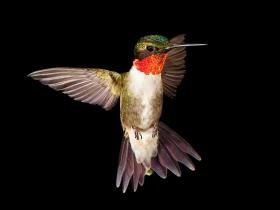Hummingbirds are among nature’s most agile fliers. They can travel faster than 50 kilometres per hour and stop on a dime to navigate through dense vegetation.
Now researchers have discovered that the tiny birds process visual information differently from other animals, perhaps to handle the demands of their extreme aerial acrobatics.
“Birds fly faster than insects and it’s more dangerous if they collide with things,” said Roslyn Dakin, a postdoctoral fellow who led the study. “We wanted to know how they avoid collisions and we found that hummingbirds use their environment differently than insects to steer a precise course.”
Scientists placed hummingbirds in a specially-designed tunnel and projected patterns on the walls to figure out how the birds steer a course to avoid collisions when they are in flight. They set up eight cameras to track the movement of hummingbirds as they flew through a 5.5-metre long tunnel.
“We took advantage of hummingbirds’ attraction to sugar water to set up a perch on one side of the tunnel and a feeder on the other, and they flew back and forth all day,” said Douglas Altshuler, associate professor in the department of zoology. “This allowed us to test many different visual stimuli.”
While not a lot is known about how birds use vision in flight, it is known that bees process distance by how quickly an object goes past their field of vision, like we do as we drive down a road. As we pass by telephone poles on the side of the road quickly, our brains understand that the objects are nearby; buildings in the distance will take some time to pass, letting us know they are further away.
When scientists simulated this type of information on the tunnel walls, the hummingbirds didn’t react. Instead Dakin and her colleagues found that the birds relied on the size of objects to determine distance. As something gets bigger, this may signal to the birds that they are getting closer, and as something gets smaller, it may signal that they are moving farther away.
“When objects grow in size, it can indicate how much time there is until they collide even without knowing the actual size of the object,” said Dakin. “Perhaps this strategy allows birds to more precisely avoid collisions over the very wide range of flight speeds they use.”
The researchers also found that the hummingbirds used the same technique as flies, known as image velocity, to assess their altitude. When the patterns on the walls simulated going up and down, the researchers found that the birds adjusted their flight.
Source: Science daily
N.H.Kh

